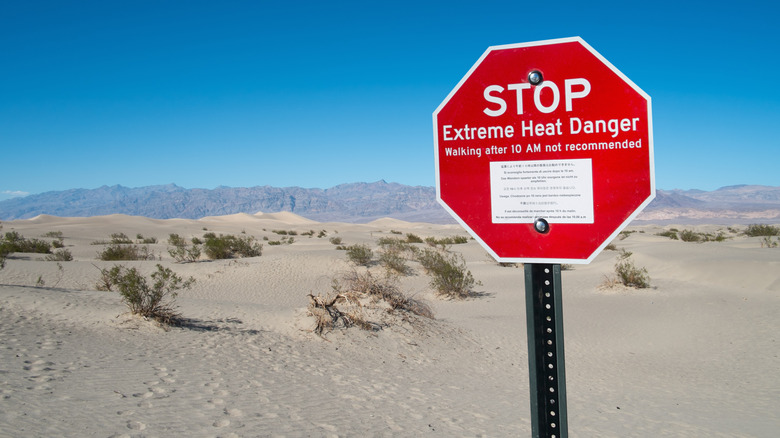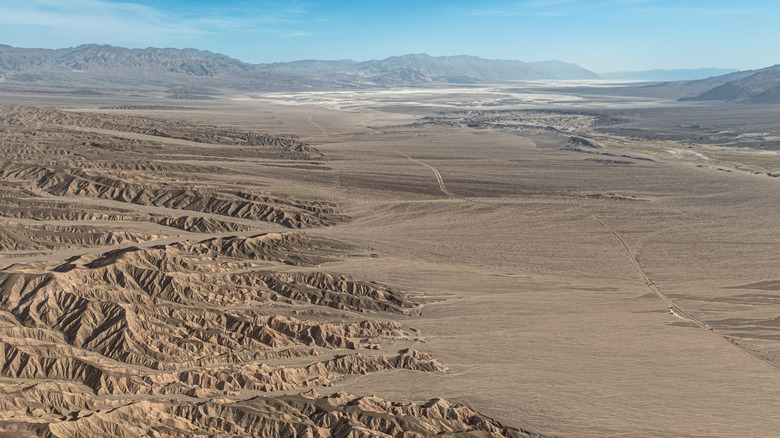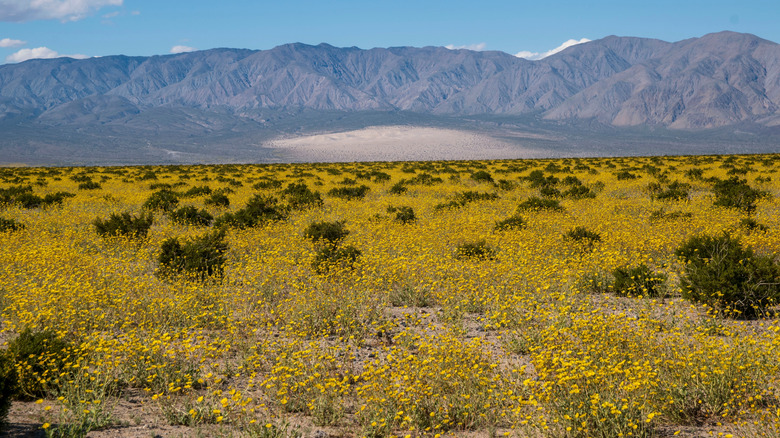California Is Home To The Hottest Place On Earth
Images of California's climate typically focus on the palm trees and beaches of Los Angeles or the foggy hills of San Francisco, but that barely scratches the surface of the nation's most climatically diverse state. Broadly speaking, California has four main regions: the coast, the mountains, the Central Valley, and the deserts, the latter of which take up much of the southeastern part of the state. California's principal desert is the Mojave Desert, and it is there that you'll find the hottest place on the planet: Death Valley.
On July 10, 1913, a Weather Bureau thermometer at Furnace Creek Ranch in Death Valley recorded a temperature of 134 degrees Fahrenheit. According to the World Meteorological Organization's World Weather and Climate Extremes Archive, this is the single hottest air temperature ever recorded on Earth. Summers in the valley are absolutely brutal, with temperatures regularly topping 120 degrees, and that's in the shade! Even at night, temperatures linger in the 90s.
Death Valley is a place of extremes. Not only is it the hottest place on Earth, but with less than 2 inches of annual rainfall, it's also the driest place in North America. Death Valley's Badwater Basin ranks as the lowest land point on the continent as well, 282 feet below sea level. That geological extreme is exactly why Death Valley is so hot today.
How Death Valley formed
Death Valley formed gradually over the course of millennia. In the climate of the Paleozoic Era roughly 542-251 million years ago, the region that is now Death Valley contained a shallow sea. The evidence of this period can still be seen in the coral fossils found in Death Valley's limestone formations.
The seawater receded during the Mesozoic Era, the first of the three periods in which the dinosaurs lived, due to tectonic activity in the region. The Rocky Mountains and Sierra Nevadas were formed in this time, and as the land rose, it pushed the water away. During the Tertiary Period, the region was rocked by volcanic activity, and finally, around 3 million years ago, a fault line split and the land was ripped in two, forming the deep gash in the desert we now know as Death Valley.
Death Valley's depth and steep mountain borders, paired with its minimal precipitation, are the key forces behind its record-setting heat. As air moves from high altitudes down to the earth, it gets warmer and warmer, and this effect is amplified by Death Valley's extreme depth. Since there are hardly any plants due to lack of moisture, there is nothing to absorb the sun's energy other than the rock walls of the valley. This essentially turns Death Valley into an oven, radiating heat in on itself, and trapping it within its high walls.
The life that thrives in the hottest place on Earth
Death Valley's extreme climate might have you assume it's an uninhabitable wasteland, but there is a shocking amount of life thriving in the valley. There are numerous species of cacti, and even some trees, including Joshua trees and bristlecone pines. Reptiles like the desert iguana and desert tortoise, a species with a lifespan on par with our own, wander the region, and migrating birds often drop by.
The animals that live in Death Valley have evolved traits that allow them to face a nearly waterless environment. In fact, the local kangaroo rat doesn't even need to drink, deriving all its water from the vegetation it eats. There is even a species of fish native to Death Valley: the desert pupfish. They are found in the few watery spots of the valley, such as Cottonball Marsh and Devils Hole, an upwelling of groundwater.
The most spectacular example of life in Death Valley is the superbloom. About once every decade, the valley explodes with a visual symphony of wildflowers. Vibrant purple and orange mariposa lilies, yellow desert dandelions, lilac sunbonnets, and more decorate the landscape. Superblooms can only occur if the valley experiences a rare rainstorm, triggered by El Niño weather events that bring early rains to California, typically in the months of September and October. As of the writing of this article, the most recent superbloom occurred in 2016, meaning another is soon to come. If there's any time to brave the hottest place on Earth, that's it.


